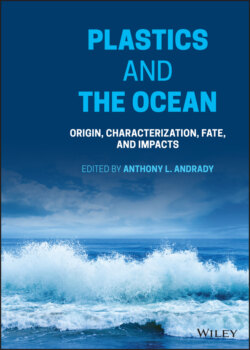Читать книгу Plastics and the Ocean - Группа авторов - Страница 28
1.6.2 Thermal Transitions
ОглавлениеWhen the temperature of an amorphous polymer is increased, the heat energy acquired by the polymer allows increasing degrees of mobility to the polymer chains. At a specific temperature, depending on the plastic, the mobility of chain molecules becomes high enough to make the plastic transition from a “glassy” material to a “rubbery” one. This critical temperature is the Glass Transition temperature, Tg (°C) (Milles et al. 2020). Glassy materials are hard and brittle as polymer chains are not free to move in response to stress imposed on the material, but heated above this critical temperature, they become more flexible. Above the TG (°C), the polymer chains still remain entangled, unable to move about freely, with only some local movement of chain segments possible. This is, however, a reversible change, and cooling the plastic reverts it back to the glassy state. Chewing gum is usually a polymer below its Tg (°C) at ambient temperatures, but when warmed to body temperature in the oral cavity (to a temperature >Tg [°C]) it becomes rubbery and flexible. Alternatively, soft polymers such as rubber, polyethylene, or protein, that are all above their Tg (°C) at ambient temperature, become glassy, hard, and brittle when cooled to below their Tg (°C) (by dipping in liquid nitrogen [‐195.8 °C]).
Figure 1.12 Left: Scanning Electron Micrograph of an ultra‐high molecular weight HDPE fiber heated at 110 °C for one hour. The crystallites oriented in the direction of the fiber axis (indicated by the arrow) can be seen. Right: Schematic of a semi‐crystalline polymer showing oriented chains in “crystalline” regions.
Source: Left: Courtesy of Miao et al., (2018).
With semi‐crystalline plastics, however, the thermal behavior is somewhat different. The amorphous fraction of the plastic behaves the same as described above and soften above its Tg (°C), but this temperature has no impact at all on the crystalline domains. But, when the plastic is heated to even higher temperatures well above the Tg, the melting temperature of the crystallites, Tm (°C) is reached, when the material changes into a fully amorphous polymer. Further heating above the Tm (°C) (and therefore >Tg [°C]), converts the polymer into a viscous liquid. Neither the Tm (°C) nor Tg (°C) are inherent properties of polymers but can be changed by its thermal and stress history.
The structure of PE was given above simply as (‐CH2‐CH2‐) n , a linear chain molecule. Commercial grades of polyethylene, however, are generally manufactured with a controlled amount of chain branching in their molecules and therefore have a range of different densities. The type of catalyst used to polymerize ethylene as well as co‐monomers (short‐chain olefins) mixed with ethylene, determine the stereo‐specificity and the chain‐branching in the polymer. Chain branching in PE interferes with the development of crystallinity and results in a polyethylene lower density. The density of the polymer is controlled by how much (the percentage) of branching is introduced, and whether these are long (>20 carbon chain) or short (5–10 carbon chain) branches. Nearly‐linear PE chains with virtually no branching can crystallize easily and results in a high‐density grade of PE called HDPE. Where significant branching is introduced, a relatively low‐density and low‐crystallinity grade of LDPE (or low‐density PE) results. A grade with branching, but mostly with shorter lengths relative to branch chains in LDPE, is the linear‐low density grade, LLDPE. Table 1.6 below summarizes the properties of common plastics encountered in the marine environment. The more crystalline HDPE is stronger than LDPE and is used, for instance, in fabricating milk‐jugs. Figure 1.13 illustrates the branching in LDPE, HDPE, and LLDPE varieties of polyethylene; there are many other commercially‐available PEs of different ρ (g/cm3). (Medium‐density PE‐MDPE ρ = 0.926–0.940; very low density PE‐VLDPE ρ = 0.890–0.895; high molecular weight PE‐HMWPE ρ = 0.947–0.955; and ultra‐high molecular weight PE‐UHMWPE ρ = 0.940.) Also in the figure are two examples of common applications of PE.
Table 1.6 Characteristics of plastics typically encountered in marine debris.
Source: Polyethylene data from Peacock (2000).
| Crystallinity (%) | Melting point (°C) | Extensibility (%) | Young’s Modulus, G (Pa) | |
|---|---|---|---|---|
| LDPE | 50–60 | 105 | 200–600 | 0.13–0.3 |
| HDPE | 60–80 | 125 | 500–700 | 0.266–0.525 |
| LLDPE | 40–60 | 125 | 300–900 | 0.5–1.1 |
| PP | 40–60 | 150–175 | 100–600 | 0.9–1.55 |
| PS (GPPS) | — | — | 1.2–2.6 | 1.2–2.6 |
| PS (HIPS) | — | — | 15–65 | |
| PVC | 10–30 | — | 11.9–80.0 | 2.14–4.14 |
| PET | 30–40 | 260 | 30–300 | 2.76–4.14 |
| Nylon 6 | — | 255 | 25–50 | |
| Cellulose Acetate |
Figure 1.13 Left: Illustration of the molecular geometry of LDPE and HDPE. Middle; LDPE sandwich bag. Right: HDPE milk jug. (Images: Courtesy of Alana Andrady)
